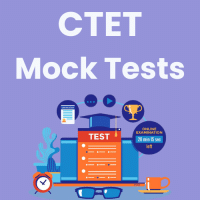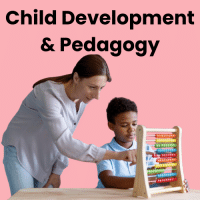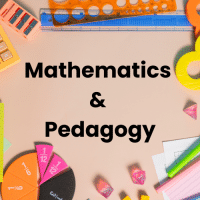CTET & State TET Exam > CTET & State TET Questions > Which one among the following situations give...
Start Learning for Free
Which one among the following situations gives the learners the best opportunity to ‘discover knowledge’?
- a)Students being instructed through ‘team teaching’ on ‘materials of daily use’
- b)Students undergoing an elaborate and detailed session of ‘programmed instruction’ on the topic ‘components of food’
- c)Students being first shown the demonstration of ‘Archimedes Principle’ followed by a detailed explanation
- d)Students labeling the given materials as ‘conductors’ and ‘non-conductors’ by placing them in a self-assembled closed electric circuit
Correct answer is option 'D'. Can you explain this answer?
Most Upvoted Answer
Which one among the following situations gives the learners the best o...
Understanding 'Discovery Knowledge'
In the context of educational experiences, the situation that provides the best opportunity for learners to discover knowledge is option 'D'. Here’s why:
Active Engagement
- Students are actively involved in the learning process by experimenting with materials.
- This hands-on approach allows learners to explore the properties of conductors and non-conductors through direct interaction.
Critical Thinking Development
- Labeling materials requires students to think critically about their characteristics.
- They must analyze and reason why certain materials behave as conductors or non-conductors, enhancing their understanding.
Self-Directed Learning
- By placing materials in a self-assembled closed electric circuit, learners take initiative in their discovery.
- This autonomy fosters a sense of ownership over their learning experience, encouraging curiosity and exploration.
Application of Theoretical Concepts
- Students connect theoretical knowledge of electricity to practical applications.
- This reinforces their learning as they see real-world relevance and implications of scientific principles.
Collaborative Learning Environment
- The activity can promote collaboration among peers, leading to discussions and shared insights.
- Such interactions can deepen comprehension and encourage diverse perspectives on the topic.
Conclusion
Overall, option 'D' provides a rich, interactive environment that not only fosters discovery but also equips students with critical thinking skills and practical knowledge, making it the most effective choice for promoting meaningful learning experiences.
In the context of educational experiences, the situation that provides the best opportunity for learners to discover knowledge is option 'D'. Here’s why:
Active Engagement
- Students are actively involved in the learning process by experimenting with materials.
- This hands-on approach allows learners to explore the properties of conductors and non-conductors through direct interaction.
Critical Thinking Development
- Labeling materials requires students to think critically about their characteristics.
- They must analyze and reason why certain materials behave as conductors or non-conductors, enhancing their understanding.
Self-Directed Learning
- By placing materials in a self-assembled closed electric circuit, learners take initiative in their discovery.
- This autonomy fosters a sense of ownership over their learning experience, encouraging curiosity and exploration.
Application of Theoretical Concepts
- Students connect theoretical knowledge of electricity to practical applications.
- This reinforces their learning as they see real-world relevance and implications of scientific principles.
Collaborative Learning Environment
- The activity can promote collaboration among peers, leading to discussions and shared insights.
- Such interactions can deepen comprehension and encourage diverse perspectives on the topic.
Conclusion
Overall, option 'D' provides a rich, interactive environment that not only fosters discovery but also equips students with critical thinking skills and practical knowledge, making it the most effective choice for promoting meaningful learning experiences.
Free Test
FREE
| Start Free Test |
Community Answer
Which one among the following situations gives the learners the best o...
Students labeling materials as conductors and non-conductors gives them the best opportunity to discover knowledge.

|
Explore Courses for CTET & State TET exam
|

|
Question Description
Which one among the following situations gives the learners the best opportunity to ‘discover knowledge’?a)Students being instructed through ‘team teaching’ on ‘materials of daily use’b)Students undergoing an elaborate and detailed session of ‘programmed instruction’ on the topic ‘components of food’c)Students being first shown the demonstration of ‘Archimedes Principle’ followed by a detailed explanationd)Students labeling the given materials as ‘conductors’ and ‘non-conductors’ by placing them in a self-assembled closed electric circuitCorrect answer is option 'D'. Can you explain this answer? for CTET & State TET 2025 is part of CTET & State TET preparation. The Question and answers have been prepared according to the CTET & State TET exam syllabus. Information about Which one among the following situations gives the learners the best opportunity to ‘discover knowledge’?a)Students being instructed through ‘team teaching’ on ‘materials of daily use’b)Students undergoing an elaborate and detailed session of ‘programmed instruction’ on the topic ‘components of food’c)Students being first shown the demonstration of ‘Archimedes Principle’ followed by a detailed explanationd)Students labeling the given materials as ‘conductors’ and ‘non-conductors’ by placing them in a self-assembled closed electric circuitCorrect answer is option 'D'. Can you explain this answer? covers all topics & solutions for CTET & State TET 2025 Exam. Find important definitions, questions, meanings, examples, exercises and tests below for Which one among the following situations gives the learners the best opportunity to ‘discover knowledge’?a)Students being instructed through ‘team teaching’ on ‘materials of daily use’b)Students undergoing an elaborate and detailed session of ‘programmed instruction’ on the topic ‘components of food’c)Students being first shown the demonstration of ‘Archimedes Principle’ followed by a detailed explanationd)Students labeling the given materials as ‘conductors’ and ‘non-conductors’ by placing them in a self-assembled closed electric circuitCorrect answer is option 'D'. Can you explain this answer?.
Which one among the following situations gives the learners the best opportunity to ‘discover knowledge’?a)Students being instructed through ‘team teaching’ on ‘materials of daily use’b)Students undergoing an elaborate and detailed session of ‘programmed instruction’ on the topic ‘components of food’c)Students being first shown the demonstration of ‘Archimedes Principle’ followed by a detailed explanationd)Students labeling the given materials as ‘conductors’ and ‘non-conductors’ by placing them in a self-assembled closed electric circuitCorrect answer is option 'D'. Can you explain this answer? for CTET & State TET 2025 is part of CTET & State TET preparation. The Question and answers have been prepared according to the CTET & State TET exam syllabus. Information about Which one among the following situations gives the learners the best opportunity to ‘discover knowledge’?a)Students being instructed through ‘team teaching’ on ‘materials of daily use’b)Students undergoing an elaborate and detailed session of ‘programmed instruction’ on the topic ‘components of food’c)Students being first shown the demonstration of ‘Archimedes Principle’ followed by a detailed explanationd)Students labeling the given materials as ‘conductors’ and ‘non-conductors’ by placing them in a self-assembled closed electric circuitCorrect answer is option 'D'. Can you explain this answer? covers all topics & solutions for CTET & State TET 2025 Exam. Find important definitions, questions, meanings, examples, exercises and tests below for Which one among the following situations gives the learners the best opportunity to ‘discover knowledge’?a)Students being instructed through ‘team teaching’ on ‘materials of daily use’b)Students undergoing an elaborate and detailed session of ‘programmed instruction’ on the topic ‘components of food’c)Students being first shown the demonstration of ‘Archimedes Principle’ followed by a detailed explanationd)Students labeling the given materials as ‘conductors’ and ‘non-conductors’ by placing them in a self-assembled closed electric circuitCorrect answer is option 'D'. Can you explain this answer?.
Solutions for Which one among the following situations gives the learners the best opportunity to ‘discover knowledge’?a)Students being instructed through ‘team teaching’ on ‘materials of daily use’b)Students undergoing an elaborate and detailed session of ‘programmed instruction’ on the topic ‘components of food’c)Students being first shown the demonstration of ‘Archimedes Principle’ followed by a detailed explanationd)Students labeling the given materials as ‘conductors’ and ‘non-conductors’ by placing them in a self-assembled closed electric circuitCorrect answer is option 'D'. Can you explain this answer? in English & in Hindi are available as part of our courses for CTET & State TET.
Download more important topics, notes, lectures and mock test series for CTET & State TET Exam by signing up for free.
Here you can find the meaning of Which one among the following situations gives the learners the best opportunity to ‘discover knowledge’?a)Students being instructed through ‘team teaching’ on ‘materials of daily use’b)Students undergoing an elaborate and detailed session of ‘programmed instruction’ on the topic ‘components of food’c)Students being first shown the demonstration of ‘Archimedes Principle’ followed by a detailed explanationd)Students labeling the given materials as ‘conductors’ and ‘non-conductors’ by placing them in a self-assembled closed electric circuitCorrect answer is option 'D'. Can you explain this answer? defined & explained in the simplest way possible. Besides giving the explanation of
Which one among the following situations gives the learners the best opportunity to ‘discover knowledge’?a)Students being instructed through ‘team teaching’ on ‘materials of daily use’b)Students undergoing an elaborate and detailed session of ‘programmed instruction’ on the topic ‘components of food’c)Students being first shown the demonstration of ‘Archimedes Principle’ followed by a detailed explanationd)Students labeling the given materials as ‘conductors’ and ‘non-conductors’ by placing them in a self-assembled closed electric circuitCorrect answer is option 'D'. Can you explain this answer?, a detailed solution for Which one among the following situations gives the learners the best opportunity to ‘discover knowledge’?a)Students being instructed through ‘team teaching’ on ‘materials of daily use’b)Students undergoing an elaborate and detailed session of ‘programmed instruction’ on the topic ‘components of food’c)Students being first shown the demonstration of ‘Archimedes Principle’ followed by a detailed explanationd)Students labeling the given materials as ‘conductors’ and ‘non-conductors’ by placing them in a self-assembled closed electric circuitCorrect answer is option 'D'. Can you explain this answer? has been provided alongside types of Which one among the following situations gives the learners the best opportunity to ‘discover knowledge’?a)Students being instructed through ‘team teaching’ on ‘materials of daily use’b)Students undergoing an elaborate and detailed session of ‘programmed instruction’ on the topic ‘components of food’c)Students being first shown the demonstration of ‘Archimedes Principle’ followed by a detailed explanationd)Students labeling the given materials as ‘conductors’ and ‘non-conductors’ by placing them in a self-assembled closed electric circuitCorrect answer is option 'D'. Can you explain this answer? theory, EduRev gives you an
ample number of questions to practice Which one among the following situations gives the learners the best opportunity to ‘discover knowledge’?a)Students being instructed through ‘team teaching’ on ‘materials of daily use’b)Students undergoing an elaborate and detailed session of ‘programmed instruction’ on the topic ‘components of food’c)Students being first shown the demonstration of ‘Archimedes Principle’ followed by a detailed explanationd)Students labeling the given materials as ‘conductors’ and ‘non-conductors’ by placing them in a self-assembled closed electric circuitCorrect answer is option 'D'. Can you explain this answer? tests, examples and also practice CTET & State TET tests.

|
Explore Courses for CTET & State TET exam
|

|
Signup for Free!
Signup to see your scores go up within 7 days! Learn & Practice with 1000+ FREE Notes, Videos & Tests.


















